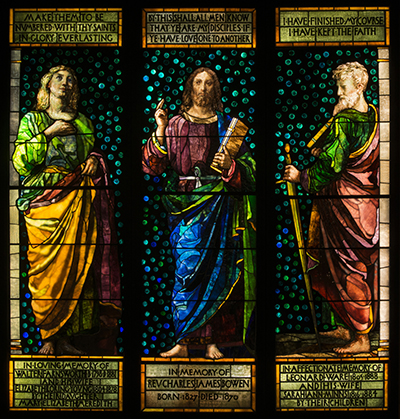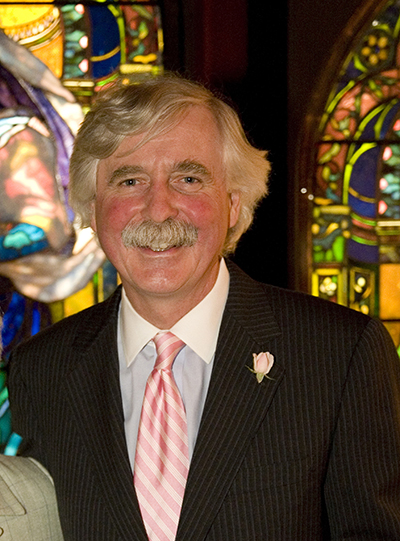The McMullen Museum of Art’s exhibition “John La Farge and the Recovery of the Sacred,” opening September 1, was occasioned by a gift bestowed on Boston College in 2013 by dealer/collectors Alison and William Vareika — a La Farge stained glass triptych, representing “St John the Evangelist,” “Christ Preaching” and “St Paul.” The Vareikas have become the foremost dealers in the artist’s work in their Newport, R.I., gallery, which they opened in 1987. William Vareika, a 1974 Boston College alum, spoke with Antiques and The Arts Weekly about his career-long fascination with the artist.
Q. We often think of L.C. Tiffany when it comes to stained glass windows. What is it about La Farge’s works that resonates with you?
A. Despite Tiffany’s notoriety, many connoisseurs of American stained glass would concur with my opinion that the windows of John La Farge are the finest ever created in the United States. La Farge originated the use of opalescent glass in the manufacture of stained glass windows and was awarded the French Legion of Honor in 1889 for his innovative stained glass work, creating “an art unknown before, an entirely new industry.” He referred to this new art form as “painting in air with a material carrying colored light.” Tiffany “borrowed” many of La Farge’s advances in glass work and the threats of lawsuits between the rivals are well-known.
Q. How did you come to own the triptych?
A. I learned in late 2012 that a Unitarian Church in Amherst, Mass., had voted to sell it, in part because they did not approve of the overt Christian imagery. Auction houses had offered the church estimates as high as $300,000, while also recommending that the triptych be broken apart and the three windows sold separately. What was most disturbing to me was the news that the church was also advised to cut off the biblical quotation panels at the top of the windows and the memorial citation panels at the bottom to make the windows more appealing on the marketplace. For me, these proposals were a desecration of the artist’s original creative concept. I believed that somehow the windows should permanently grace the walls of a new art museum facility, and I knew that Boston College was planning to construct one. My wife and I made an offer to the Amherst church to purchase the windows and gift them to BC. The offer was initially rejected by the church trustees, but after I made a presentation to a church committee about my lifetime work with La Farge and my dream to bring the windows to BC, the church reconsidered and accepted our offer.
Q. What are the specific items in need of restoration?
A. All old stained glass windows require conservation. The lead structure of the windows becomes unstable over the years due to exposure to weather and the natural deterioration of the leading due to the weight of the glass. Also the glass becomes dirty from pollution and the weather and the gas and candlelight smoke of Nineteenth Century churches. In the conservation process, every piece of glass in a window is disassembled and cleaned, restored if cracked, and then reassembled, sometimes with new leading or using the original leading when stable.
Q. Tell us about the moment when you became captivated by La Farge’s murals.
A. I had meditated many times in Trinity Church in Copley Square Boston when a sophomore at BC in 1971, as I had a part-time work-study job at the Boston Public Library, directly across the street. It was the one private, quiet place in a busy neighborhood. The very day that I had to come up with a topic for my term paper in an art history course, I awoke from my meditation and saw the La Farge murals and stained glass windows in a new way, as if I had never seen them before, inspiring me to propose La Farge as the topic of my term paper.

John La Farge (1835–1910), “St John the Evangelist,” “Christ Preaching,” “St Paul,” circa 1889, stained glass, 99 by 31 inches each. McMullen Museum of Art, Boston College, gift of William and Alison Vareika, 2015.
Q. How many of La Farge’s works have you previously gifted to BC, and are they similarly devoted to religious themes?
A. My wife and I gifted 14 John La Farge artworks to the McMullen Museum at BC in 2004 during my 30th graduation class anniversary. Most were selected as having religious subject matter. We also included the only extant oil portrait of the artist’s wife, Margaret Mason Perry La Farge, painted around 1860, the year of their marriage in Newport.
Q. How does the museum plan to display the triptych?
A. The windows will be displayed at the entrance to the BC exhibition at the McMullen Museum in large light boxes, with similar light as they would be seen in a church setting in full sunlight. They will be permanently displayed in light boxes directly in front of the entrance to the foyer of the new McMullen Museum, slated to open in 2016.


